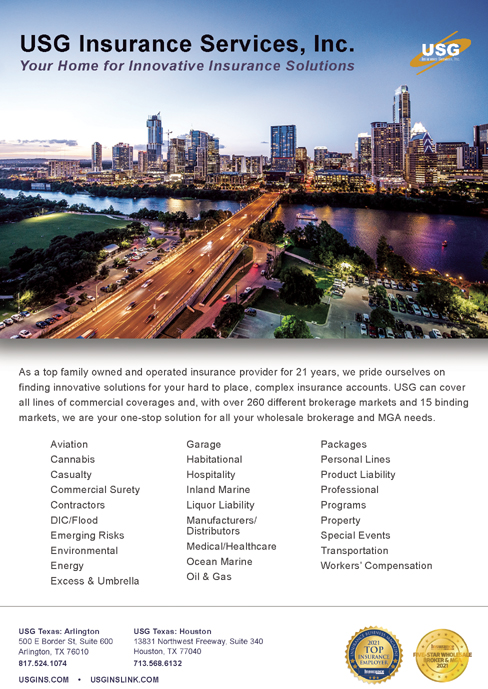The near 15 percent growth in surplus lines premium in Texas in 2021 reported by the Surplus Lines Stamping Office of Texas was record breaking. Still, in terms of growth rate, Texas lagged behind the growth rate of the 14 other states reporting surplus lines premium through stamping or service offices.
Excess and surplus lines premium recorded by the 15 U.S. surplus lines stamping and service offices exceeded $51.0 billion in 2021, a 22.28 percent increase over the $41.7 billion reported for 2020. Texas slipped to a third place position among the largest E&S premium states, with Florida edging out Texas by about $420 million in premium. All 15 states reported double digit increases in reported premium, ranging from 14.87 percent growth in Texas to 40.12 percent growth in Illinois.

Executive directors of several states’ servicing offices cited rising costs of coverage for cyber liability and property risks as major drivers of premium growth.
Texas was the only state to report any decrease in items processed, processing 19 fewer in 2021 than in 2020. Still, said Greg Brandon, executive director of the SLTX, the item count in Texas made up 20 percent of items reported from the 15 reporting states. In 2020, there had been a 1.27 percent decline in items processed across these states, so WSIA found the 6.6 percent increase in items processed by the reporting states to represent a “rebound,” according the association’s Jan. 25 media release.
Idaho and Utah led the growth in item count. WSIA attributed their substantial increases in transaction counts as likely due to their substantial increases in population growth. Idaho’s item count in 2021 was 23.2 percent greater than 2020, and Utah’s item count grew by 12.9 percent.
Among the top five states, Texas was the only state to report a decline in the number of new and renewal policies processed by the stamping or service offices. Florida’s policy count increased by 5.36 percent; California, 7.09 percent; New York, 9.50 percent, and Illinois, 9.11 percent. The policy count in Texas decreased by 2.54 percent from the prior year.
Dan Maher, executive director of the Excess Line Association of New York (ELANY) pointed to the U.S. data, noting that for most of the country it shows that the admitted market’s appetite for some risks has seen a shift of insureds into the surplus line market. “The shift is across numerous lines of business,” said Maher, “business from property with CAT loss exposures to liability risks such as excess, umbrella, D&O and cyber where social inflation and new exposures are of serious concern.”
With a slower premium growth rate than the rest of the service office states and lower item and policy filing counts, Texas might appear to be an anomaly to this shift from the admitted market. However, Brandon said that data collected by SLTX is insufficient to provide a perspective on the state’s admitted market. Still, said Brandon, “the data shows the nonadmitted market appetite remains strong. While 2021 premium growth percentages do not match the growth of other states, Texas premium growth was very robust and continues to align with the historical annual growth rate over the last six years.”
Texas E&S premium made up 17.85 percent of the total premium reported through service offices even though Texas’ premium growth percentage was the lowest among the 15 states. Together, the top four states, California, Florida, Texas and New York, reported 74.9 percent of all premium that is reported to service offices.
Premium reported by Illinois had the largest percentage increase at 40.12 percent. David Ocasek, CEO of the Surplus Line Association of Illinois said, “Our numbers were incredibly strong, especially in the third and fourth quarters. General and excess liability categories, including commercial general liability, cyber, pollution, products, and employment practices liability, led the way with a 60 percent increase versus prior year. Property, including all risk, increased 23 percent.”
Still, Illinois’ reported premium made up only 5.8 percent of all reported premium in 2021 in these states.
North Carolina recorded the third highest premium increases of the service office states at almost 35 percent. “We saw greater than 100 percent increases in premium on classes of business such as cyber liability, excess personal liability and miscellaneous liability,” said Geoff Allen, COO of the North Carolina Surplus Lines Association. “The largest increase in the number of transactions filed for a class of business in 2021 was primary residential flood insurance.”
California, the country’s largest surplus lines insurance market, reported premium increases of nearly 18.4 percent and a 7.1 percent increase in transactions. David Kodama, executive vice president of the Surplus Line Association of California said, “The SLA recorded significant increases in item count and average premium for various coverages, including cyber, property and commercial auto. This growth coincides with reported increased activity in data breaches, ransomware attacks, wildfires, increased auto loss severity and emerging social and cost inflation.”
Commenting on the surplus lines industry trend, ELANY’s Maher said, “I see a lot of new capacity in the E&S market which should moderate or stabilize pricing as that capacity is deployed in 2022.”
Stamping office states accounted for 63 percent of all U.S. surplus lines premium volume in 2020 providing a valuable indicator of the state of the total U.S. surplus lines market, said WSIA in its media release. These statistics are gathered and reported individually by each state stamping office and the data on premium and item count is aggregated and summarized by WSIA on their behalf.





Recent Comments